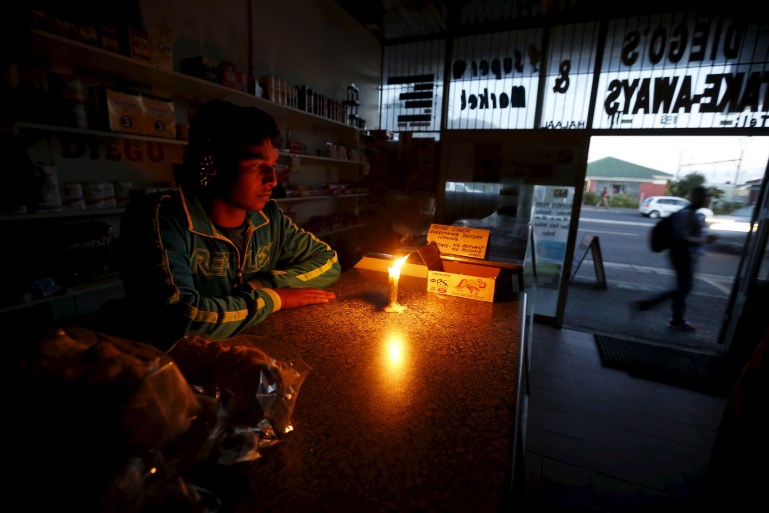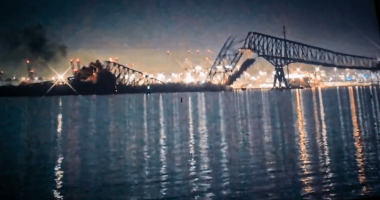“I set up my company several years ago. The power cuts were bad then, lasting up to five hours a day,” said Lezanne Viviers, who works in the fashion industry and lives in Johannesburg, South Africa’s biggest city.
Since 2007, electricity cuts have become so common that Eskom – the state-owned electricity supplier – has devised a schedule for them. It calls these periods of national exasperation “load shedding”.
“We weren’t ready for it. But us South Africans are very resilient,” Viviers told Al Jazeera. “When there was load shedding, we worked with our hands and made use of the sunshine. I also bought a back-up engine. That was useful, as some power outages last year persisted all-day.”
More recently the country has experienced uninterpreted power for 57 days – the longest consecutive period in over two years – drawing allegations of electioneering ahead of next week’s general ballot.
Still, many companies have bought back-up diesel generators or solar panels, often at the expense of other investments and hiring. For small or informal businesses that cannot afford secondary supplies, working around the blackouts – or not working at all – is unavoidable.
In 2023, power outages mothballed factories, offices and shops to the tune of 926 million South African rand ($51m) a day, according to the country’s Reserve Bank.

“I installed a solar panel a few years ago to avoid dealing with electricity failures altogether,” Viviers added. “I know the next government faces numerous challenges. But making sure the lights work for most people seems like a good place to start.”
Power woes are not the only challenge confronting the country of 62 million. Decades of low-maintenance and a lack of investment have led to crumbling transport networks and water supplies.
The ruling African National Congress (ANC), which has been in power since the end of apartheid in 1994, is in danger of losing its parliamentary majority on the back of decrepit infrastructure – a key voting issue.
In a BrandMapp-Silverstone online survey (PDF) conducted last year, two-thirds of middle-income respondents said they would consider rejecting the governing party due to years of power failures.
Trouble at Eskom
For decades, Eskom’s ageing coal-powered plants have been poorly maintained and undermined by theft, especially of coal and copper. Elsewhere, accusations of corruption abound.
Once hailed as a first-rate utility company, it has become a byword for dysfunction. In 1990, Eskom was self-financing and provided some of the world’s cheapest electricity, albeit to the minority white South Africans and businesses.
After apartheid, the drive to extend electricity to all South Africans – particularly in the country’s growing townships – was not matched by investment in new power stations. At the same time, rising international coal prices, Eskom’s principal cost, squeezed returns.
Then from 2009 to 2018, under President Jacob Zuma, Eskom would be at the heart of what became known as “state capture” – in which individuals and companies commandeered the state to redirect public resources into private hands, and gutting those institutions in the process.
Last February, President Cyril Ramaphosa was forced to declare a state of disaster as blackouts lasted up to 12 hours per day. The government provided $14bn of debt relief to Eskom to free up money for plant maintenance and network improvements.
But South Africa’s National Treasury conditioned the bailout on unpopular tariff increases. Eskom was also split into separate units – namely generation, transmission and distribution. Unbundling, it was claimed, would make Eskom easier to manage.
At the same time, licensing requirements on green power stations were scrapped. Since then, private investment in wind farms and nuclear plants has increased. “We’re slowly unwinding Eskom’s near-monopoly on power,” said Azar Jammine, chief economist at consultancy Econometrix.
The private sector now generates 10.4 gigawatts of electricity, close to half of Eskom’s functioning capacity. Looking ahead, Jammine thinks that will continue to rise.
“Private companies can produce up to 100 megawatts of power… a few years ago it was just 1,” he said. “Large users of electricity are increasingly able to bypass Eskom by producing their own power. Households are doing the same with solar panels.”
“That partly explains the lack of load-shedding recently,” Jammine told Al Jazeera. “It’s a sign that energy policy is headed in the right direction. The country is moving away from its reliance on Eskom and coal, and the private sector will continue playing a big role in that.”
He added that “energy policy is headed in the right direction under the ANC”.
“In all honesty, I’m more worried about my taps than my lights.”

‘It just spills on to the streets’
In South Africa, most water reservoirs are powered by electricity. Power outages, in turn, can prevent treatment plants from running their pumps. Earlier this year, patchy energy coverage left taps dry across much of Johannesburg.
In addition to poor power coverage, Rand Water – Johannesburg’s water board – claims that nearly half of all piped water is lost to leaks. “It just spills underground or on to streets,” said Richard Meissner, associate professor of politics at the University of South Africa (Unisa) in Pretoria.
Nationally, it is estimated that 70 million litres of potable water are forfeited to spillage every day. “For starters, municipal delivery systems are old,” said Miessner. “Johannesburg’s water infrastructure, for instance, was designed during the interwar years.”
“Second,” he added, “water plants are subject to vandalism. Looters take everything from metal parts to pumps and then sell them off. Third, we don’t have a culture of maintenance in South Africa, especially in rural areas.”
Part of the problem is “low revenues,” Meissner added. Johannesburg’s local government says that water users owe 16 billion rand ($880m) in unpaid bills.
“Then there’s poor management,” he said. Across South Africa, municipalities owe 18 billion rand ($959m) to water boards.
Looking ahead, water insecurity will be exacerbated by climate change. In Meissner’s view, “local authorities will need to start awarding more maintenance contracts to private companies in exchange for utility revenues. It’s the only cash flow they’ve got.”
South Africa enshrined access to water as a fundamental right in 1994, more than a decade before the United Nations. “But there’s a growing recognition of the need to shift away from total state control,” said Meissner. “Greater private sector participation looks inevitable, and not just in water.”

Transnet, South Africa’s state-backed rail company is also mired in mismanagement and corruption allegations.
Last year, rickety railways prompted excess storage of exports at warehouses and ports. According to the Treasury, turmoil at Transnet cost the economy as much as 6 percent of gross domestic product (GDP) in 2023.
The company recently warned it cannot maintain its 130 billion rand ($7.2bn) debt without direct state help. And while President Ramaphosa has signalled a desire to help, he’s also hinted at enhanced private involvement in South Africa’s train lines.
“Rail, energy and water are all in need of reform,” Meissner told Al Jazeera, though he conceded that overtures to private companies would not fix all of South Africa’s infrastructure problems.
“But until public debt becomes more manageable, we’re likely to see closer relationships between state monopolies and private capital,” he said.
Caught in a debt bind
As voters get ready for next week’s election, South Africans face myriad issues. Nearly half of all young people are out of work while 56 percent of the population live in poverty. Voter discontent has also been fuelled by soaring crime rates and corruption scandals.

During the last election in 2019, the governing ANC received 57 percent of the vote. Its support has since slumped. The party is still expected to gain the largest share of votes on May 29. But it will probably have to form a coalition to stay in power.
The country’s finances have deteriorated over the past decade. Expensive bailouts for Eskom and Transnet have put pressure on state coffers. External conditions, meanwhile, have been unfavourable.
COVID-19 and the war in Ukraine, which raised borrowing costs and softened the rand, challenged South Africa’s debt sustainability. Last year, its debt-to-GDP ratio swelled to 74 percent.
The government currently spends more than one-fifth of tax revenues servicing interest payments on its debt, drawing money from other areas – like education, healthcare and infrastructure.
“South Africa’s debt burden will be a challenge for the next government,” said Aurelien Mali, a senior credit officer at Moody’s Investors Service. “They don’t want it to balloon to levels where they can’t deliver on other services.
“Strengthening policies to reduce fiscal drags will be key, especially around unemployment,” he said. Moody’s estimates that 30-35 percent of South Africans are unemployed, leaving a big gap in lost tax income and foregone economic activity.
“Clearly,” insisted Mali, “the absorption of non-workers into South Africa’s labour market would be good for lots of reasons. But tax revenue isn’t necessarily one of them. Taxes already make up 27 percent of GDP, which is higher than most emerging market countries.”
Instead, Mali urged the next government to focus on job creation. By providing incentives for greater private infrastructure investment, “the government could address debt, power and water all at once. It could also boost South Africa’s manufacturing sector.”
“This is going to be a multi-decade programme,” he added. “But if we start to see meaningful improvements to South Africa’s infrastructure, it could create a virtuous circle of development. There’s already a plan, now it’s a question of implementation.”
Read More: World News | Entertainment News | Celeb News
Aljazera










